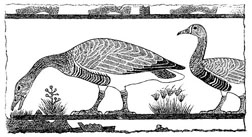1902 Encyclopedia > Mural Decoration > Painting and Mural Painting: Introduction; Egyptian Painting.
Mural Decoration
(Part 8)
PAINTING AND MURAL DECORATION
Painting: The Most Widely Used Form of Wall Decoration. Egyptian Painting.
This is naturally the most important and the most widely used of all forms of wall-decoration, as well as perhaps the earliest.
Egyptian Paintings.—Egypt is the chief storehouse of ancient specimens of this, as of almost all the arts. Owing to the intimate connexion between the sculpture and painting of early times, the remarks above both as to subjects and treatment under the head of Egyptian wall-sculpture will to a great extent apply also to the paintings. It is a very important fact, and one which testifies clearly to the enormous antiquity of Egyptian civilization, that the earliest paintings, paintings, dating more than 4000 years before our era, are also the cleverest both in drawing and execution. In later times the influence of Egyptian art, especially in painting, was very important among even very distant nations. In the 6th century B.C. Egyptian colonists, introduced by Cambyses into Persepolis, largely influenced the painting and sculpture of the great Persian empire and throughout the valley of the Euphrates. In a lesser degree the art of Babylon and Nineveh had felt considerable Egyptian influence several centuries earlier. The same influence affected the early art of the Greeks and the Etrurians, and it was not till the middle of the 5th century B.C. that the further development and perfecting of art in Greece obliterated the old traces of Egyptian mannerism. After the death of Alexander the Great, when Egypt came into the possession of the Lagidae (329 B.C.), the tide of influence flowed the other way, and Greek art modified though it did not seriously alter the characteristics of Egyptian painting and sculpture, which still retained much of their early formalism and severity. And yet the increased sense of beauty, especially in the human face, derived from the Greeks was counterbalanced by loss of vigour and force; art under the Ptolemies ceased to have a real life and became a mere dull copyism of earlier traditions.
The general scheme of mural painting in the buildings of ancient Egypt was very complete and magnificent Columns, mouldings, and other architectural features were enriched with patterns in brilliant colours; the flat wall spaces were covered with figure-subjects, generally in horizontal bands, and the ceilings were richly ornamented with sacred symbols, such as the vulture, or painted blue and studded with gold stars to symbolize the sky. The wall-paintings are executed in tempera on a thin skin of fine lime, laid over the brick, stone, or marble to form a smooth and slightly absorbent coat to receive the pigments, which were most brilliant in tone and of great variety of tint. Not employing fresco, the Egyptian artists were not restricted to "earth colours," but occasionally used purples, pinks, and greens which would have been destroyed by fresh lime. The blue used is a very beautiful colour, and is generally laid on in considerable body—it is frequently a "small" or deep-blue glass, coloured by copper oxide, finely powdered. Red and yellow ochre, carbon-black, and powdered chalk-white are most largely used. Though in the paintings of animals and birds considerable realism is often seen (fig. 7), yet for human figures certain conventional colours are employed, e.g., white for females’ flesh, red for the males, or black to indicate people of negro race.

Fig. 7 -- Egyptian Wall-Painting of the Ancient Empire, in the Bulak Museum. Taken from Loftie's Ride in Egypt.
Heads are painted in profile, and little or no shading is used. Considerable knowledge of harmony is shown in the arrangement of the colours; and otherwise harsh combinations of tints are skillfully softened and brought into keeping by thin separating lines of white or yellow. Though at first sight the general colouring, if seen in a museum, may appear crude and gaudy, yet it should be remembered that the internal paintings were much softened by the very dim light that was sparingly admitted into Egyptian buildings, and those outside were subdued by contrast with the brilliant blue sky and glowing sunshine under which they were always seen.[Footnote 40-1]
Footnote
(40-1) See Champollion, Panthéon Égyptien (1825); De Joannis, Peintures murales … des Égyptiens; Biechy, La Peinture chez les Égyptiens (1868) ; Lenormant, Antiquités Égyptiennes; Lepsius, Denkmäler aus Aegypten; Wilkinson, Anc. Egypt.; Descr. De l’ Égypte (Paris, 1821. &c.); Perrot et Chipiez, L’Art de’Égypte (1880), and other works on Egypt.
Read the rest of this article:
Mural Decoration - Table of Contents
|
